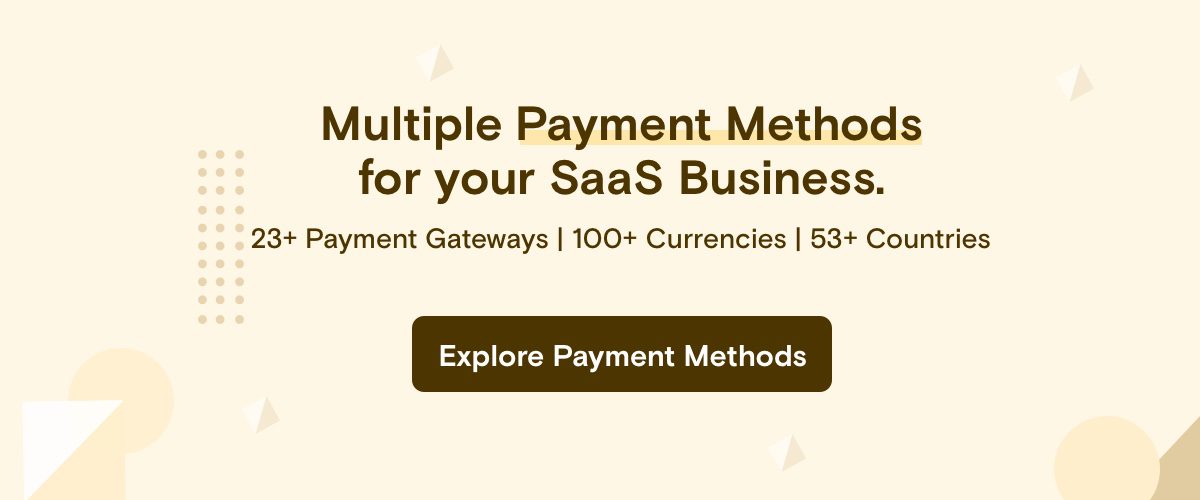The doorbell rings. You find a salesman at your doorstep, holding this huge sealed carton with numerous colorful labels and CTA stickers on it. From the labels, you’re quick to realize that it’s a product that you’ve been looking for, and your interest is piqued.
And then the salesman drops the bomb. You aren’t allowed to open the box until you buy the product.
Well, would you:
A – Go ahead, pay him what he asks for, and get that sealed carton
or,
B – Turn down the offer, watch him leave, and go about minding your work?
Now replace that carton with your product’s website. Do you see what I’m getting at?
A free trial is indispensable in SMB SaaS. “Try before you buy” has become the de facto approach to buying SaaS products. So much so, that if you think that it is not applicable to your business, you must have a very compelling reason why you’ll be able to sell your product without letting your customers try it out before they purchase your product.
The baseline is this: Unless people like your product, they wouldn’t want to share their personal details with you. And that absolutely makes sense.
(One exception could be the enterprise software products, where offering a demo will make more sense than offering a free trial. This one deserves a post of its own, and hence we shall stick to the main topic for now.)
To increase the conversion rate of his product, Quick Sprout Traffic System, Neil Patel experimented with two options: a free trial with a credit card and a money-back guarantee, and guess what? Turns out that a free trial brought in more revenue as opposed to a money back guarantee.
But wait.
Does this mean that if you’re offering a free trial, you should ask for the user’s credit card information during sign-up? How will that affect the results of the free trial? Card or no card – which way to go?
Let’s take a look at both sides of the coin, learn what their perks and pitfalls are, when to use them, and how to nail them right.
Free Trial with Credit Card
Who have taken this route?
Moz, AWS, ConvertKit, etc.
What makes it work?
If you ask for a credit card number during a free trial, two outcomes are bound to happen:
- Reduced sign-up rates
- Improved lead quality
Granted, the sign-up rate will be lower compared to this model’s counterpart, but the trial-to-paid conversion will be higher. The logic is quite simple: only those with a serious intent, and who can afford your product would go ahead and type in their card number. The rest would simply bounce off.
Here, you’re allowing the users to qualify themselves while signing up for your service, which also takes a huge load off your sales team’s shoulders – a qualified opt-in.
A considerable number of startup founders have picked this strategy, and have their own set of justifications to back the choice:
- For an independent developer who makes SaaS products, resources can especially be scarce, and they can’t afford to spend on the wrong users and tire-kickers. By asking for card details upfront, they get to focus only on those users who are actively interested in what they’re selling.
- Speaking of tire-kickers, by not asking for credit card details during sign-up, you’ll be allowing users to create multiple accounts with multiple IDs, thus letting them use your free trial perpetually, and abuse your server.
- Brennan Dunn from Planscope found that without the credit card capturing process, he had no idea why trial users didn’t convert. With a free trial that asks for credit card particulars, he got to receive quality feedback from the users when they canceled their accounts (Note: A cancellation survey is a great way of capturing qualitative data when a user cancels their account).
Who is this suitable for?
A company that’s hitting the growth pedal, is looking for fewer sign-ups and more revenue per user (RPU)
If that’s what you want, then ask for the credit card details during the trial sign-up process.
So you have a smaller number of sign-ups, where most of them will definitely be qualified, thus bringing you more revenue.
If you’re picking this route, ensure that your pricing is aligned in a way that you’re maximizing your revenue from your handful of sign-ups; the win ratio has to be higher, and the revenue from each customer has to be higher as well.
Initially, Statuspage.io offered its customers a free tier and a $49/mo premier tier only. And in over two years, they’ve raised their prices twice (with the highest tier about 8x of their initial price), and have raised their ARPU from $49 to $116. What’s more surprising? It didn’t negatively affect their conversion at all.
Pro tips
- Once you receive the credit card details during sign-up, perform a $1 pre-authorization to make sure that the card is valid, like how Moz does it. Being proactive has its own perks, you know.
- Also, to reduce the friction in the sign-up process, go for a two-step account creation process. Ask for personal details on the first page and for the card details on the second page. This way, you can also capture the information of those users who abandon the sign-up form on the second page, thus giving you a chance to reach out to them later on.
- Instead of asking the users for their credit card details, you can ask them to sign up using PayPal. The users trust PayPal, they don’t have to explicitly share their card details, they know that they can cancel their subscriptions easily, and hence will be more comfortable signing up.
Accept recurring credit card payments in multiple currencies->
Free Trial without Credit Card
Who have taken this route?
Hubspot, Chargebee, Basecamp, etc.
What makes it work?
If there’s one obvious benefit of having a sign-up process that doesn’t require credit card information, it’s minimal or no friction, which in turn will shoot up the sign-up rate.
As per one of Totango’s reports, companies that didn’t require credit card information showed a higher end-to-end conversion percentage when compared to those that asked for the information for the free trial.
So what else was the underlying reason behind this data?
“Trust”, says Lincoln Murphy. According to him, by setting up the credit card barrier, you’re only adding to the distractions, and affecting the trust factor. He also warns that in some cases the trial-to-paid conversions in a free trial with a credit card method might be accidental, where the customer had no idea that their card was charged. Such situations will inevitably lead to them sending you emails requesting refunds.
If anything has changed in the last few years, it’s that people have become LESS trusting… not more. Less willing to whip out the credit card to TRY something. Why? Because 100% free options abound. So they don’t need to. Couple that with the fact that people are busier and more distracted, and asking for a Credit Card up front (what I call putting up a CC-Wall) becomes yet another distraction rather than something that helps them move forward to becoming your customer. Distractions + Lack of Trust = Fail.
Who is this suitable for?
Here you have two scenarios:
1. A company that’s just coming out with the beta version of its product
Typical characteristics of such a product will be that it caters to a niche set of audience, and hasn’t found its product-market fit yet. So the primary focus should be acquiring paying/non-paying customers who can evaluate the product, and give you honest feedback.
If your intent is to get more people to try out your product, then the best option is to make your sign-up process as frictionless as possible: no credit card details required, no strings attached.
For starters, you can offer the visitors two options (with two different CTA buttons), where one asks for card details and one doesn’t, and A/B tests the sign-up conversion percentage for yourself.
To give you a real-world example, let’s take MailChimp (which doesn’t ask for card details in the free trial) and AWeber (which has a $1 sign-up process).
A user might end up spending more with MailChimp at a later stage, but will initially go with MailChimp because they face no friction when they want to try out the product. The user’s logic is simple: When I don’t even know whether I want to buy the product or not, why would I pay a dollar for it?
If you want your product in more people’s hands, then it’s a no-brainer. Just go for the frictionless, no-credit-card-required sign-up process.
2. A company that’s hitting the growth pedal, is looking for more sign-ups and less revenue per user (RPU)
In this case, you remove credit card requirements, get more sign-ups, qualify them better, try to win more of them, and thus earn more.
This method has its own set of pitfalls. The sales team has to meticulously qualify the leads. If you don’t qualify the trial users well, you’ll end up with a leaky bucket; you’ll be spending quality time in conversations, but with the wrong guys.
Your sales team has to be well-trained in how to qualify leads and how to spend more time with those qualified leads.
Pro Tips
- At the end of your specified free trial period, try introducing this offer to the trial users: “If you give us your credit card details, we will extend your free trial by one or more weeks, so that you can gain some more free usage.”
This way, customers qualify themselves and you don’t have to spend your sales effort to qualify them. Use your product to sell itself and qualify the customers. And here, because the users have entered the card details, they’ll automatically be moved to the paid plans at the end of the extended trial period – a default opt-in instead of a default opt-out.
- One downside of this approach is that the commitment and the seriousness of the trial users would be comparatively lesser, as they have nothing to lose. In many cases, the users might forget that they had even signed up with you in the first place.
So it becomes all the more important for you to get them engaged, and to get them to realize the value of your product as soon as possible. Determine the Common Conversion Activities (CCAs) of your most active customers, motivate your trial users to perform those activities, and design your app to support the same. In fact, this process helped in boosting our trial-to-paid conversion rate from 8% to 15%.
Wrapping things up (with a bonus tip)
A special treat for the numbers people! Venture capitalist Christopher Janz has given a pretty neat model to check which strategy works for your business. Here’s the sheet.
Basically, you just have to replace the blue values with your company’s values and watch the magic happen. Head here to read more on that(you’re welcome!).
There you have it. Set your priorities straight, pick the free trial strategy that best fits your situation, ensure that you have everything set to tackle the hiccups, and most importantly, get your customers to truly experience the value of your offering.
To summarize, here’s a presentation covering all the points discussed above:


